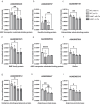The twin-arginine translocation system is vital for cell adhesion and uptake of iron in the cystic fibrosis pathogen Achromobacter xylosoxidans
- PMID: 37974335
- PMCID: PMC11533796
- DOI: 10.1080/21505594.2023.2284513
The twin-arginine translocation system is vital for cell adhesion and uptake of iron in the cystic fibrosis pathogen Achromobacter xylosoxidans
Abstract
Achromobacter xylosoxidans is an emerging pathogen that causes airway infections in patients with cystic fibrosis. Knowledge of virulence factors and protein secretion systems in this bacterium is limited. Twin arginine translocation (Tat) is a protein secretion system that transports folded proteins across the inner cell membranes of gram-negative bacteria. Tat has been shown to be important for virulence and cellular processes in many different bacterial species. This study aimed to investigate the role of Tat in iron metabolism and host cell adhesion in A. xylosoxidans. Putative Tat substrates in A. xylosoxidans were identified using the TatFind, TatP, and PRED-Tat prediction tools. An isogenic tatC deletion mutant (ΔtatC) was generated and phenotypically characterized. The wild-type and ΔtatC A. xylosoxidans were fractionated into cytosolic, membrane, and periplasmic fractions, and the expressed proteome of the different fractions was analysed using liquid chromatography-mass spectrometry (LC-MS/MS). A total of 128 putative Tat substrates were identified in the A. xylosoxidans proteome. The ΔtatC mutant showed attenuated host cell adhesion, growth rate, and iron acquisition. Twenty predicted Tat substrates were identified as expressed proteins in the periplasmic compartment, nine of which were associated with the wild type. The data indicate that Tat secretion is important for iron acquisition and host cell adhesion in A. xylosoxidans.
Keywords: Twin-arginine translocation; achromobacter xylosoxidans; bacterial protein secretion; cystic fibrosis; infection; iron metabolism.
Conflict of interest statement
No potential conflict of interest was reported by the authors.
Figures





References
-
- Foundation CF. Patient Registry Annual data Report 2021. 2021. Available from: https://www.cff.org/sites/default/files/2021-11/Patient-Registry-Annual-...
Publication types
MeSH terms
Substances
LinkOut - more resources
Full Text Sources
Other Literature Sources
Medical
